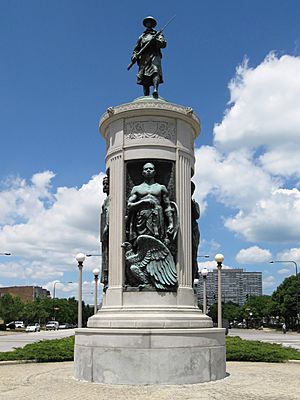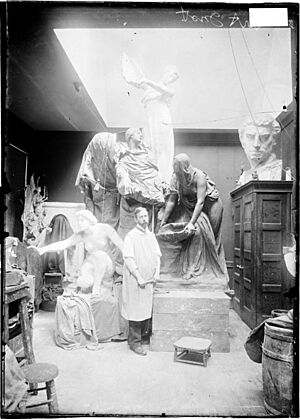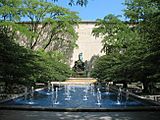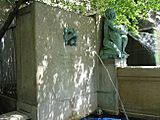Fountain of the Great Lakes facts for kids
Quick facts for kids Fountain of the Great Lakes |
|
|---|---|

View facing east in Art Institute of Chicago South McCormick Court
|
|
| Artist | Lorado Taft |
| Year | 1907–1913 |
| Type | Bronze |
| Dimensions | 670 cm (264 in) |
| Location | Art Institute of Chicago, Chicago, Illinois, U.S. |
The Fountain of the Great Lakes, also called the Spirit of the Great Lakes Fountain, is a special sculpture and fountain created by Lorado Taft. It's made of bronze and was built between 1907 and 1913. The fountain shows five women. The way water flows from them is meant to remind you of how water moves through the five Great Lakes in North America.
In the real Great Lakes, water starts in Lake Superior, which is about 600 feet (183 meters) above sea level. Then, it flows east through each lake until it reaches Lake Ontario. This fountain is one of Taft's most famous artworks. You can find it in the public South McCormick Memorial Court at the Art Institute of Chicago in the Chicago Loop.
The fountain was first put in place facing south. It stayed there until 1963. Then, it was moved next to the Morton Wing addition and now faces west. When it was in its first spot, you could see it from the Jackson and Michigan Avenue intersection. This area was once known as "route center." The fountain was paid for by the Benjamin Ferguson fund. One part of the fountain even mentions the name B. F. Ferguson Fountain of the Great Lakes. There's a sculpture carved into a flat surface of Benjamin Ferguson on the back. This part has been hidden since the fountain was moved.
This fountain was the first project paid for by the Ferguson Fund. It faced some delays in getting money. Also, the rules about using land in Grant Park were changing at the time. This caused delays in choosing where to put the fountain. Once it was built, most people liked it a lot.
The Story Behind the Fountain
The fountain was funded by a large gift of money from Benjamin F. Ferguson in 1905. He gave about $1 million to create artworks that would "remember events in American History." This money also paid for many other public artworks in Chicago. The city was trying to decide how to use this fund. Taft suggested using the money for fountains, statues that tell stories, small sculptures of people's heads, and decorating bridges and park entrances. He wanted to create lasting beauty and support the kind of art he liked. By September 1905, newspapers were already talking about him as a possible artist for the fund's first project.
During 1905 and 1906, Taft started focusing more on sculpture in his classes at the School of the Art Institute of Chicago. At the same time, he was improving his ideas for symbolic artworks. The Fountain of the Great Lakes was Taft's answer to a complaint made by Daniel Burnham. At the World's Columbian Exposition in 1893, Burnham said that the sculptors decorating the fairgrounds didn't create anything that showed the great natural resources of the west, especially the Great Lakes.
In the spring of 1902, Taft had given his students a project called Spirit of the Great Lakes. Five women students each made a figure. They then put them together in a tiered group, imagining water flowing from the containers they held. By January 1906, Taft made a plaster version of the fountain. He showed it to Charles L. Hitchinson, a trustee of the Ferguson Fund, on January 17 at Taft's Midway Studios. By the end of January, the Art Institute of Chicago displayed the artwork during its yearly exhibition of local works.
The fountain gained a lot of support during its four-week display. It won the Chicago Municipal Art League's top sculpture award. Taft also won the Society of Chicago Artists' Medal for overall excellence for this and two other head sculptures. The chairperson of the Municipal Art League exhibition, Mrs. William F. Grower, decided to form a special group. This group would help make sure the public's wish for the fountain to be the first Ferguson fund commission came true. However, even after the court allowed the money to be given to the trustees on May 23, 1906, no project was started. The trustees couldn't decide between a statue or a portrait.
Choosing a Location

Since 1836, Grant Park has been protected by a law that says it must be "forever open, clear and free." This law has been upheld by several rulings from the Illinois Supreme Court. Aaron Montgomery Ward sued the city of Chicago twice. He wanted the city to remove buildings from Grant Park and stop building new ones. The second lawsuit was still ongoing in 1906. This legal uncertainty about building in Grant Park caused delays.
While the trustees remained quiet, Taft tried to get more public support. He published a picture of Spirit of the Great Lakes in Century Magazine. This made Buffalo, New York, interested in having the finished artwork. By February 1907, the Buffalo Illustrated Times published a cover with an image of the fountain. The caption said that the Beautifying Buffalo Society hoped to get the artwork for their city. However, by the end of 1907, Taft and his connections with the Trust Fund settled his commission.
On October 31, 1907, the Ferguson Trust Board voted to give Taft the project. On December 16, he signed a contract for $38,000 to start work. This was the first project funded by the Ferguson fund. Even with the money agreement, it took some time to decide where to put the artwork. Ward's lawsuit continued to cause problems. One idea was to put it in Grant Park south of the Art Institute. Another idea was to put it at the 35th Street and Grand Boulevard (now Martin Luther King, Jr. Drive) intersection. This spot now has the Chicago Landmark and National Register of Historic Places-listed Victory Monument.
The 1909 Art Institute yearly report mentioned a plan for a sunken garden with a fountain south of the Institute. Legal issues about land use became more intense in 1910. The Art Institute then started making smaller plans for the fountain, almost attached to the south wall of its own building. For the next few years, there wasn't much talk about the fountain. Taft was busy with other projects. Then, in May 1913, the fountain model at Taft's Midway Studios was taken apart. It was sent to Jules Berchem's foundry to be cast in bronze. Shepley, Rutan and Coolidge designed the base for the sculpture. It was put together by mid-August, ready for its dedication on September 9, 1913.
In 1963, a new part of the Art Institute of Chicago Building, called the Morton wing, was built. The fountain was moved from its south-facing spot next to the original building. It used to be seen from the Historic Michigan Boulevard District. Now, it's on the west wall of the new wing, facing west. The sculpture was placed so that the plaque on the back is no longer easy to read. This plaque says that the "fund must be used for erecting and maintaining enduring statuary and monuments."
Taft's Legacy
Lorado Taft is now better known for his books, like The History of American Sculpture. This book is seen as the first complete work on the topic. But in his time, he was famous for portraits and large public sculptures that told stories, especially public fountains. This fountain was made after he was asked to design sculptures for William Le Baron Jenney's Horticultural Building. During this time, he created several large public artworks, including Fountain of Time.
When the fountain was dedicated, Taft said that getting the Ferguson Fund project to sculpt the fountain was a big moment in his career. It brought him more attention, more projects, and more recognition in the community. This encouraged him to keep working in the arts. He hoped that the Fountain of the Great Lakes would start a new era of making cities more beautiful. He also hoped it would mark the beginning of the Chicago school of sculpture. The dream that Chicago would be the center of the sculpting world began during the World's Columbian Exposition twenty years earlier. It was brought back to life with the Ferguson gift. The Fountain of the Great Lakes was a major achievement for Taft's career. It helped him become more than just a portrait artist.






